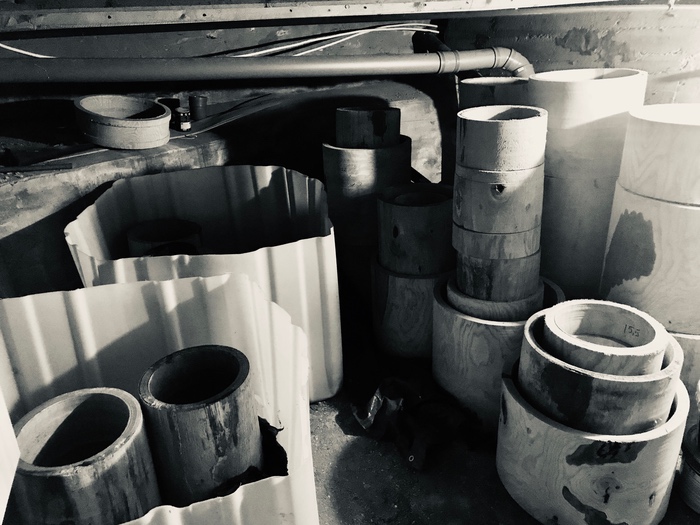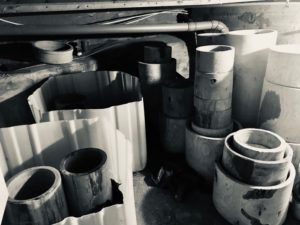
About the drums
The drums are hand turned in different tree species growing in the geographical area near workshop in Norway. Thus far, drums have been made in this workshop from Oak, Ash, Bech, Maple, wild Cherry tree, Sallow and Asp.
Selection of individual trees and which parts of each tree going into the drums is carefully done, based on extensive year-long experince. The first hints to whether an individual section of an invidual tree will give a drum shell that will not crack or bend out of shape(loose its roundness) are seen already in the first step of the drying process.
The wooden cylinder is turned in two stages. First turning is done while the wood is still fresh to give ca. 1 inch thick cylinders, which are then put away for drying. This allows the (now) hollow cylinder to dry from both inside and outside. This first drying stages takes 1-2 years, after which the cylinders are put in the lathe and turned a second time to produce a shell with desired thickness and bearing edge shape, also seeking to draw out the individual material character of each shell.
SWD drums are compatible with all types of skins, and most SWD drums are made to standard inch-based drum skin measures to fit with mass produced as well as hand made drum skins.
The instruments carry a simplicity and naturalness in every sense. Most of SWD’s instruments are finished with plant oils and natural wax. Every tree species has its characteristic properties (density, wood fibre structure etc.) which also reflects in the sound. In addition to genetic differences between species, the Nordic climate with its long winters and the immediate surroundings where each individual tree has grown (open landscape vs. thick forest, type of soil, altitute, local microclimate etc.), will also affect the tree and ulimtaely the sound of the instrument.
Every tree sort has its own characteristics which also reflects in sound. In addition to these genetic differences, the nordic climate have a big influence with its long winters. And the enviroment the tree grows up in, open lanscape vs thick forest, hills vs hollows and type of soil, all this will effect the tree and in the end also the sound.
SWD has in their interest to keep the natures quality and take care of its differences. The question about the best sort of tree, dosen’t exist. Every drum has its own colour in form of genetics, climate and form.It is a main principle for SWD to seek to preserve nature and maintain/promote natural diversity. This also translates to the philosophy of species versus drum sound. There is no «best» tree species for making drums. Rather, as result of the interaction between the craftsperson and the individual tree, with its genetic makeup, microclimate, shape, age and so forth, each drum will be unique in its visual appearance and sonic colour.
Om trommene
Trommene er hånddreid i ulike tresorter som er å finne i de geografiske omgivelsene til verkstedet i Norge. Eik, ask, bøk, lønn, bjørk, villkirsebær, selje og osp er tresorter som er benyttet fram til i dag.
Hvert treemne er nøye utvalgt, og erfaring har med tiden gjort det lettere fra begynnelsen av å velge hvilke enkelttærer som sannsynligvis vil være velegnet til trommemaking. Som en fasit vil den første tørkeprosessen raskt vise hvordan emnet vil klare seg; om det vil holde formen eller om det vil sprekke eller vris ut av form og miste sin rundhet.
Trommeemnet blir dreid i to omganger. Første omgang skjer når treet er ferskt. Sylindere blir dreid til ca. 1 tomme tykkelse og deretter satt bort til langsom tørking. Den hule tresylinderen kan da tørke både fra innsiden og utsiden, og sannsynligheten for at den sprekker er mindre. Etter 1-2 års tørkeprosess er emnet klar for andre omgang i dreiebenken. Da blir mål som ønskes på bærekanten, tykkelse og form for den ferdige trommesargen til.
SWD er kompatibel med alle typer skinn, og de aller fleste trommene er laget i ordinære tommestørrelser og kan derfor brukes med masseproduserte såvel som håndlagede skinn.
Instrumentene har en enkelhet og naturlighet på alle sanselige vis. Trommene blir behandlet med planteoljer og voks.
Alle tresorter har sine særegne egenskaper som også gjenspeiles i lyden, og hver tresort har igjen forgreninger og interne variasjoner. tillegg til disse genetiske ulikhetene har det nordiske klimaet stor påvirkning med sine lange vintre. Oppvekststed og mikroklima har også mye å si, slik som jordsmonn, tett skog, kolle eller dalsøkk osv. Alt dette påvirker treet og dermed også trommes lydlige egenskaper og utseende.
(Nibio. 2019. URL: https://www.nibio.no/tema/skog/skoggenetiske-ressurser/treslag-i-norge)
Det er i SWDs interesse å bevare naturen ivareta naturmangfold. En grunntanke i SWD er at det ikke finnes én beste tresort for trommer. Hvert instrument blir til i samspill mellom håndverkeren og det enkelte tre/emne, med sin genetikk, klima, form alder osv., som i sin tur gjør at hver tromme blir unik i både utseende og lydlige egenskaper.



